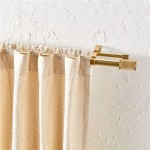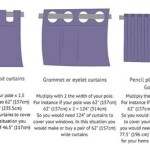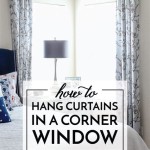Curtain Solutions for Side Windows Adjacent to the Front Door
Side windows, often referred to as sidelights, are narrow vertical windows flanking the front door. These architectural features are designed to introduce natural light into the entryway, enhancing the aesthetic appeal and perceived spaciousness. However, sidelights also present unique challenges concerning privacy, light control, and energy efficiency. Selecting appropriate window coverings, specifically curtains, for these areas requires careful consideration of various factors, including fabric, style, and hardware.
The primary function of a curtain in this context is to provide adjustable privacy. During daylight hours, curtains can filter sunlight while preventing outsiders from peering directly into the home. At night, when interior lights are on, curtains become even more crucial for obscuring the view from the outside. Beyond privacy, curtains can also contribute to insulation, minimizing heat loss during colder months and reducing solar heat gain during warmer periods. Furthermore, they can add a decorative element to the entryway, complementing the overall interior design.
Due to the narrow and often elongated shape of sidelights, standard curtain sizes and styles are generally unsuitable. Customization or adaptation is often necessary to achieve a proper fit and desired functionality. The installation process also demands attention to detail, ensuring that the curtains operate smoothly and securely without obstructing the door's operation.
The following sections will delve into key considerations for selecting and installing curtains for side windows adjacent to the front door, focusing on practical solutions for privacy, light control, and aesthetic integration.
Fabric Selection Considerations for Sidelight Curtains
The choice of fabric is a critical determinant of a curtain's performance and appearance. Several properties of the fabric must be evaluated in relation to the specific needs of the entryway. These properties include opacity, weight, texture, color, and maintenance requirements.
Opacity: Opacity dictates the level of light filtration and privacy afforded by the curtain. Sheer fabrics offer minimal privacy, allowing a significant amount of light to pass through. These are suitable for situations where privacy is not a primary concern but diffused light is desired. Semi-sheer fabrics offer a moderate balance between light filtration and privacy, blurring the view from the outside while still allowing some natural light to enter. Opaque or blackout fabrics provide the highest level of privacy, completely blocking light from entering the room. These are ideal for those seeking maximum privacy or needing to control light for sleep or media viewing.
Weight: The weight of the fabric influences its drape and overall appearance. Lightweight fabrics tend to drape gracefully and create a soft, airy feel. Heavier fabrics offer a more structured and substantial look. The weight of the fabric should be appropriate for the chosen curtain style and hardware. Too heavy a fabric may strain the hardware, while too light a fabric may not provide adequate coverage or insulation.
Texture: The texture of the fabric adds visual interest and tactile appeal. Smooth fabrics, such as silk or satin, create a sleek and elegant look. Textured fabrics, such as linen or velvet, add depth and dimension. The texture of the fabric should complement the existing decor and architectural style of the entryway.
Color: The color of the curtain fabric can significantly impact the overall ambiance of the space. Light colors reflect light, making the room appear brighter and more spacious. Dark colors absorb light, creating a more intimate and cozy atmosphere. The color of the fabric should be chosen to complement the existing color scheme and create the desired mood.
Maintenance: The maintenance requirements of the fabric should also be considered. Some fabrics require professional cleaning, while others are machine washable. The choice of fabric should be based on the homeowner's lifestyle and willingness to maintain the curtains properly. Durable and easy-to-clean fabrics are generally preferred for high-traffic areas such as entryways.
Common fabric choices for sidelight curtains include linen, cotton, polyester blends, and thermal fabrics. Linen offers a natural look and good light filtration. Cotton is a versatile and affordable option. Polyester blends are durable and easy to care for. Thermal fabrics provide enhanced insulation and energy efficiency. The selection process should consider these factors holistically to determine the most suitable material for the specific needs of the application.
Curtain Styles and Hardware Options for Sidelights
Beyond the fabric, the style of curtain and the associated hardware play a crucial role in functionality and aesthetics. Several curtain styles are suitable for sidelights, each with its own advantages and disadvantages. The hardware selection should complement the chosen curtain style and ensure smooth and reliable operation.
Rod Pocket Curtains: Rod pocket curtains are a simple and classic option. They feature a sewn-in pocket at the top through which a curtain rod is inserted. This style is easy to install and creates a gathered or ruched appearance. However, rod pocket curtains can be difficult to open and close smoothly, especially if the fabric is heavy. They are best suited for situations where the curtains are to remain stationary most of the time.
Tab Top Curtains: Tab top curtains feature fabric loops or tabs sewn along the top edge, which are used to hang the curtain from a rod. This style creates a more casual and contemporary look. Tab top curtains are easier to open and close than rod pocket curtains, as the tabs allow the curtain to slide more freely along the rod. However, the tabs can sometimes be visible, which may not be desirable for all aesthetic preferences.
Grommet Top Curtains: Grommet top curtains feature metal or plastic rings inserted into the top edge of the fabric. The curtain rod is then passed through these grommets. This style creates a clean and modern look. Grommet top curtains are very easy to open and close, as the grommets allow the curtain to slide smoothly along the rod. However, grommet top curtains require a specific type of rod designed to accommodate the grommets.
Tie-Up Curtains: Tie-up curtains are designed to be raised and lowered using ties or ribbons. This style provides adjustable light control and privacy. Tie-up curtains create a more casual and rustic look. They are suitable for situations where the curtains are frequently adjusted. However, tie-up curtains can be less formal than other styles and may not be appropriate for all decor styles.
Cafe Curtains: Cafe curtains only cover the lower portion of the window, providing privacy while allowing natural light to enter through the upper portion. This style is often used in kitchens and bathrooms but can also be suitable for sidelights in certain situations. Cafe curtains create a more open and airy feel. They are a good option for those who want to maintain some level of privacy without completely blocking the view.
Hardware Considerations: The selection of curtain hardware should be based on the chosen curtain style and the overall aesthetic of the entryway. Curtain rods are available in a variety of materials, finishes, and styles. The rod should be sturdy enough to support the weight of the curtains and should be appropriately sized for the width of the sidelight. Brackets are used to attach the rod to the wall or window frame. The brackets should be securely mounted and positioned to provide adequate support. Curtain rings or clips may be needed depending on the curtain style. These should be chosen to match the finish of the rod and brackets.
For sidelights, specialized hardware designed for narrow spaces is often required. Telescoping rods or tension rods can be used to avoid drilling into the door frame. Magnetic rods can be attached directly to metal door frames, providing a simple and non-invasive installation option. The choice of hardware should be made with careful consideration of the specific dimensions of the sidelight and the desired level of functionality.
Installation Techniques for Sidelight Curtains
Proper installation is crucial for ensuring the functionality and longevity of sidelight curtains. The installation process involves several steps, including measuring the window, selecting the appropriate hardware, and mounting the curtains securely.
Measuring the Window: Accurate measurements are essential for ensuring a proper fit. Measure the width and height of the window opening carefully. For rod pocket or tab top curtains, add extra width to allow for gathering or ruching. For grommet top curtains, measure the distance from the top of the window to the desired location of the rod. For tie-up curtains, measure the desired length of the curtain when fully extended. These measurements will dictate the required fabric dimensions.
Selecting Hardware: Choose hardware that is appropriate for the chosen curtain style and the specific dimensions of the sidelight. Ensure that the rod is sturdy enough to support the weight of the curtains and that the brackets are securely mounted. Consider using specialized hardware designed for narrow spaces, such as telescoping rods or tension rods, to avoid drilling into the door frame.
Mounting the Hardware: Use a level to ensure that the rod is mounted straight. Mark the location of the bracket holes using a pencil. Drill pilot holes into the wall or window frame. Attach the brackets to the wall or window frame using screws. Ensure that the brackets are securely fastened and can support the weight of the curtains. For metal door frames, magnetic rods can be attached directly to the frame without drilling.
Hanging the Curtains: Slide the curtain rod through the rod pocket, tabs, or grommets. Hang the rod on the brackets. Adjust the curtains as needed to ensure that they are properly positioned and draped. For tie-up curtains, adjust the ties or ribbons to raise and lower the curtain to the desired height. For cafe curtains, attach the curtain rod to the brackets positioned halfway up the window.
Securing the Curtains: Consider using tiebacks or holdbacks to keep the curtains open during the day. Tiebacks are fabric straps or cords that are used to gather the curtains to the side. Holdbacks are decorative hooks or knobs that are mounted to the wall or window frame to hold the curtains in place. These accessories can add a decorative touch and prevent the curtains from obstructing the door's operation.
Addressing Specific Challenges: Uneven sidelights, where one sidelight is shorter than the other, require customized solutions. In such cases, it may be necessary to hem the curtains to different lengths to achieve a uniform appearance. Similarly, sidelights with unusual shapes or angles may require custom-made curtains to ensure a proper fit. Professional installation may be necessary for complex or challenging situations.
By carefully considering these installation techniques, homeowners can ensure that sidelight curtains are properly installed and function effectively, providing privacy, light control, and aesthetic enhancement to the entryway. Attention to detail and the use of appropriate hardware are essential for achieving a professional and long-lasting result.

Sheer Sidelight Curtain Fits Windows Between 5 To 13 Wide Custom Made Curtains Single Panel Etsy

72 X26 Seymour Energy Efficient Front Door Sidelight Curtain Panel Gray Sun Zero Room Darkening French

Sidelight Curtains Sheer Fabric

27 Curtains For Sidelights Ideas Front Doors With Windows Door

1 Panel Front Door Curtain Window Drapes Blackout For Sidelights Privacy Protect French

Miulee Sidelight French Door Blackout Curtain Thermal Insulated Drapes Light Blocking 1 Panel Grey W25xl40

Sheer Linen Look Sidelight Curtain Single Panel Semi Privacy

Sheer Door Curtain Side Curtains For Small Window 25 W X 72 L Teal

1 Panel Front Door Curtain Window Drapes Blackout For Sidelights Privacy Protect French

Sidelight Curtain Panel Not Sheer Semi Private 25 Wide Fits Side Windows 6 14 W Colors Sold Per No Ruffle Free Tieback Band Etsy








